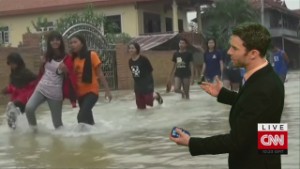- Back to Home »
- Epic flooding ravages Malaysia
- More than 132,000 Malaysians have been evacuated
- Another 100 millimeters (4 inches) of rain could fall on the Malaysian-Thai border
- The area is at risk for landslides and mudslides
(CNN) -- Even by Malaysian standards, this flooding is epic.
Neighborhoods turned into islands surrounded by a sea of murky brown water. Streets doubled as rivers. Cars were swept away and toppled over.
The flooding has forced more than 132,000 people to evacuate, Malaysia's official Bernama news agency said.
Strong currents and interrupted power supply are adding to the chaos, Prime Minister Datuk Seri Najib Tun Razak told reporters.
 Severe flooding hits southeast Asia
Severe flooding hits southeast Asia "Clean water supply too cannot be delivered, and flood victims at the temporary relief centers had to endure darkness without electric supply," he said, according to Bernama.
The flooding ravaging Malaysia started more than a week ago. While the region is accustomed to monsoons, the "northeast monsoon" that has gripped Malaysia, Indonesia and southern Thailand is particularly harsh.
Here's how it works, CNN meteorologist Derek Van Dam said Saturday:
Strong high pressure develops over Eastern Europe and China and strengthens northeasterly winds from the South China Sea, bringing heavier rainfall over Malaysia, Indonesia and southern Thailand.
And it's going to get worse. Another 100 millimeters (4 inches) of rain could fall over the next two days near the Malaysia-Thailand border, he said.
"That leaves open all kinds of possibilities -- more flooding, and the possibility of landslides and mudslides," Van Dam said.
Across the Bay of Bengal, Sri Lanka has been hit hard, too.
Kandy, in the center of the island nation, received more than twice the average monthly rainfall in just the past eight days, Van Dam said.
CNN's Radina Gigova contributed to this report.







